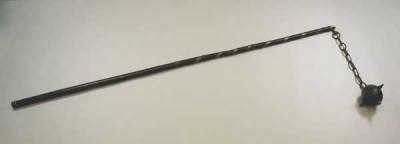Flail (1884.14.1)
 IndiaFlail from India, Asia. Part of the Pitt Rivers Museum Founding Collection. Given to the Museum in 1884.
IndiaFlail from India, Asia. Part of the Pitt Rivers Museum Founding Collection. Given to the Museum in 1884.
One of the most fearsome-looking weapons in the Museum, this flail evokes images of warfare and torture in medieval Europe. In fact, it comes from India, although we do not know how old it is. Such weapons, consisting of a haft joined to one or more balls (with or without spikes) by a metal chain, are often mistakenly called 'morning stars' (after the German Ketternmorgenstern). However, this term more accurately refers to a mace with a fixed metal ball head covered in large spikes. Here, the ball is of wood and only four metal pikes are set about its circumference. Maces and flails were relatively rare in India, originally imported from Persia and the West. In the 19th century, examples were recorded near Vizianagram in northern Andhra Pradesh as being worn by men primarily as a mark of distinction.





